My Spicy Pork and Bean Sprout Miso Soup packs complex flavor into a 10-minute dish. Chicken stock serves as the base for rich pork belly, aromatic garlic chives, savory miso, and sweet-spicy chili paste. It’s a satisfying soup for busy weeknights!

I love making different types of miso soup to keep things interesting at the dinner table. Today’s recipe, Spicy Pork and Bean Sprout Miso Soup, wakes up the senses with its savory, aromatic, spicy, sweet, and nutty flavors. I’ll show you how to make this delicious and easy one-pot dish in just 10 minutes.
If you’re craving more miso soup, try my Homemade Miso Soup, Tonjiru (Pork and Vegetable Miso Soup), and Kabocha Miso Soup recipes next!
Why I Love This Recipe
- It’s so quick – This soup takes just 10 minutes to make from start to finish. It’s ideal for a weeknight dinner or anytime you want an easy, nourishing soup.
- It has complex flavors – This miso soup is at once savory, spicy, sweet, nutty, and aromatic. It’s an exciting flavor combo that I love serving to my family.
- Chicken stock is the soup base – I use easy-to-find chicken stock (or broth) in this recipe to complement the flavors of the pork belly, garlic, and garlic chives.
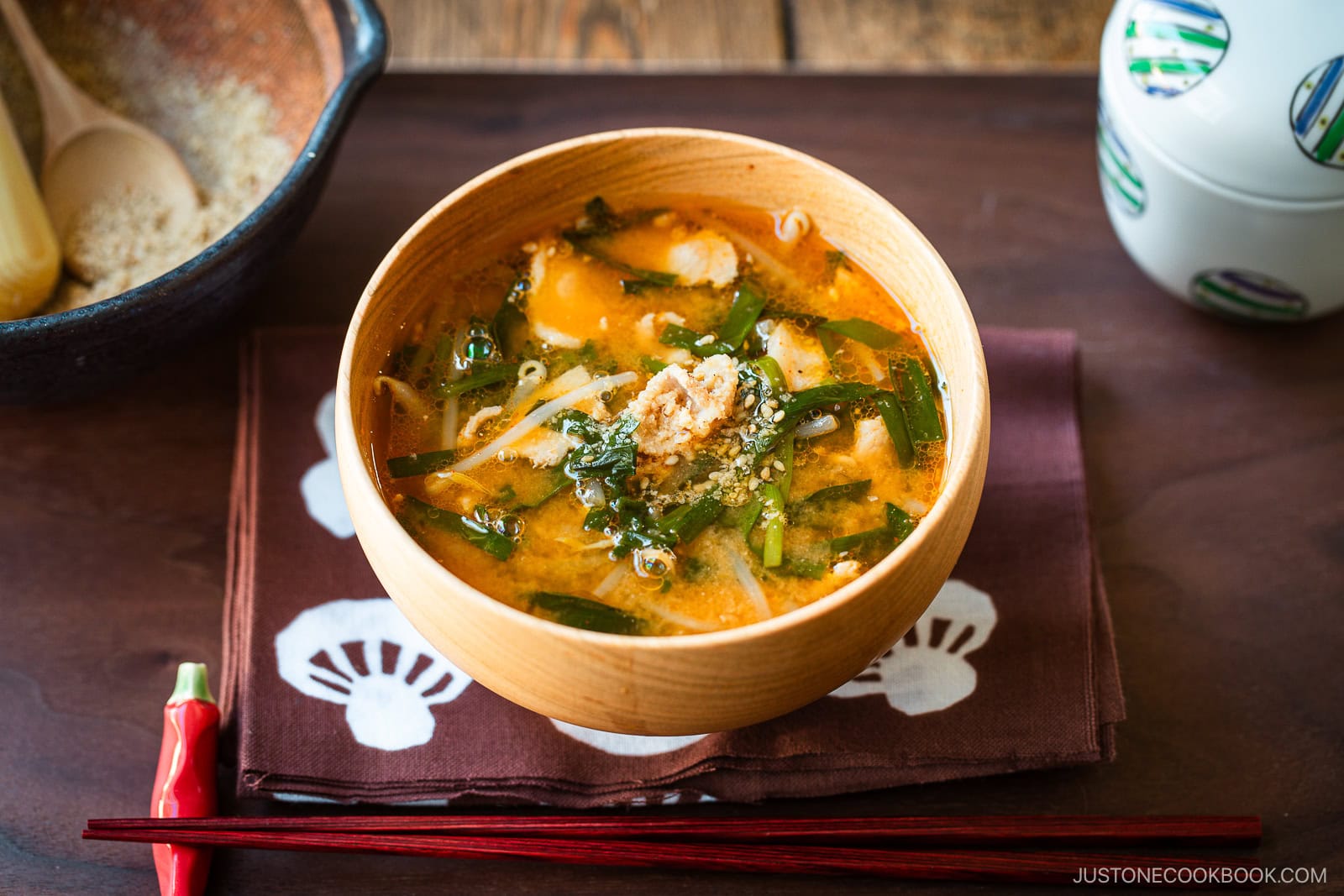
Ingredients for This Recipe
- Chicken stock/broth and water
- Miso (Japanese fermented soybean paste)
- Gochujang (Korean chili paste)
- Sliced pork belly
- Bean sprouts – mung bean sprouts or soybean sprouts
- Garlic chives (nira or Chinese chives)
- Toasted sesame oil
- Garlic cloves
- Kosher salt and black pepper
- Toasted white sesame seeds – for garnish
Find the printable recipe with measurements below.
Substitutions
- Sliced pork belly: I sometimes use a combination of pork belly and leaner pork loin. If you can’t find sliced pork belly at Japanese or Asian grocery stores, use your choice of protein. For vegetarian/vegan, you can replace it with tofu, mushrooms, or veggies.
- Miso: You can use any type. The most common ones you’ll find in the Japanese grocery store are white miso, red miso, and awase miso. I use additive-free, red koji miso from Hikari Miso that you can find on Amazon.
- Chicken stock or broth: Store-bought works, or use homemade if you have it. The sodium level of each brand differs, so taste the soup and adjust accordingly with more water or a pinch of sea salt. You can substitute vegetable stock or broth, too.
- Gochujang (고추장): This Korean fermented red chili paste has sweet, savory, and spicy flavors, although the spice level can differ by brand. It’s available at Korean and Asian grocery stores or on Amazon. In this recipe, you can substitute spicy chili sauces such as doubanjiang (spicy chili bean paste) or sriracha sauce.
- Garlic chives: Called nira or Chinese chives, they add a mild aroma and taste. If you don’t have them, you could substitute green onions (scallions) or regular onions.

How to Make This Miso Soup
Preparation
Step 1 – Slice. Cut the garlic chives and sliced pork belly into 2-inch pieces.

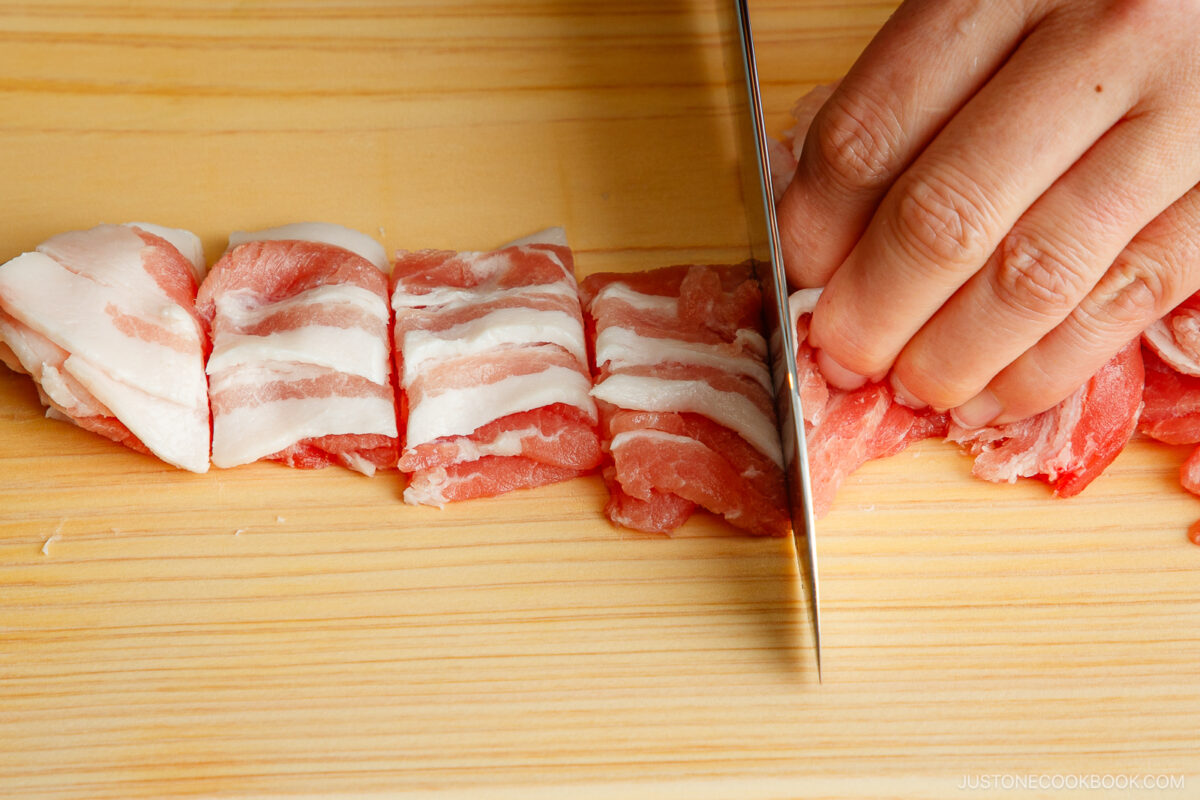
Cooking
Step 2 – Cook the pork. Stir-fry in sesame oil on medium heat in a large pot. Once cooked, season with salt, black pepper, and minced garlic.
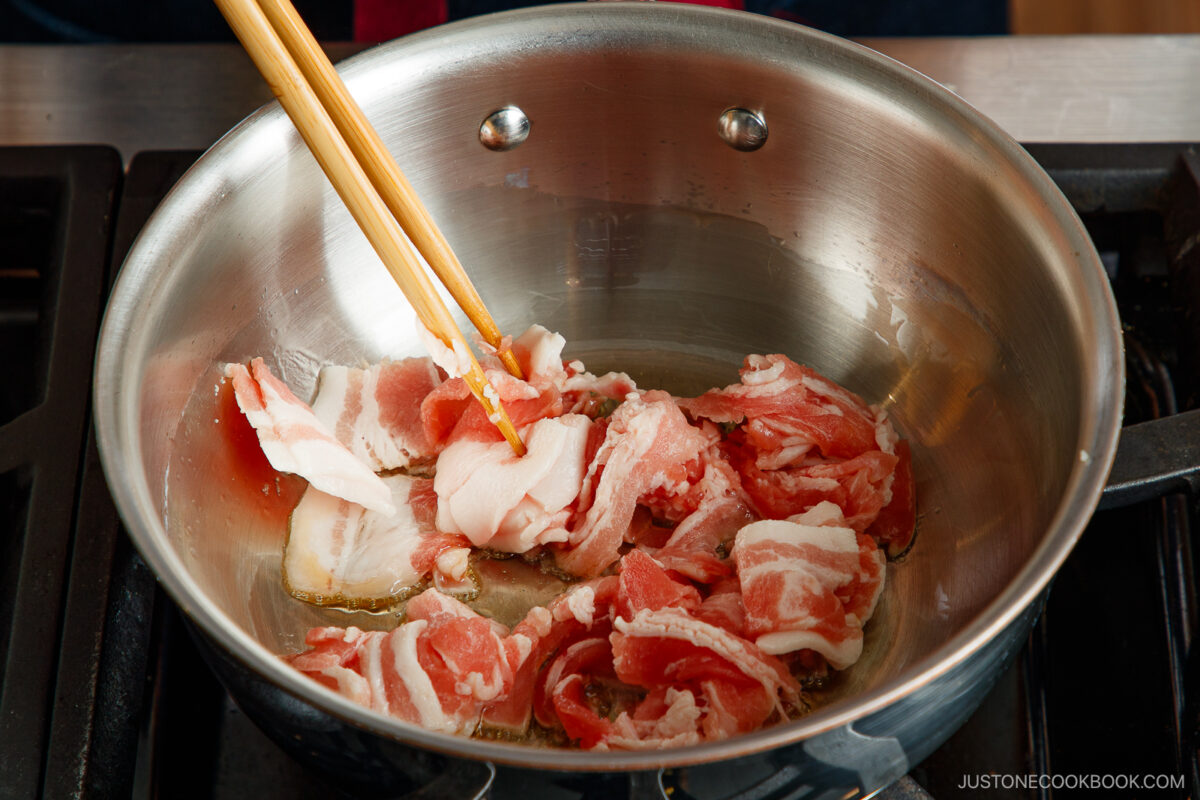
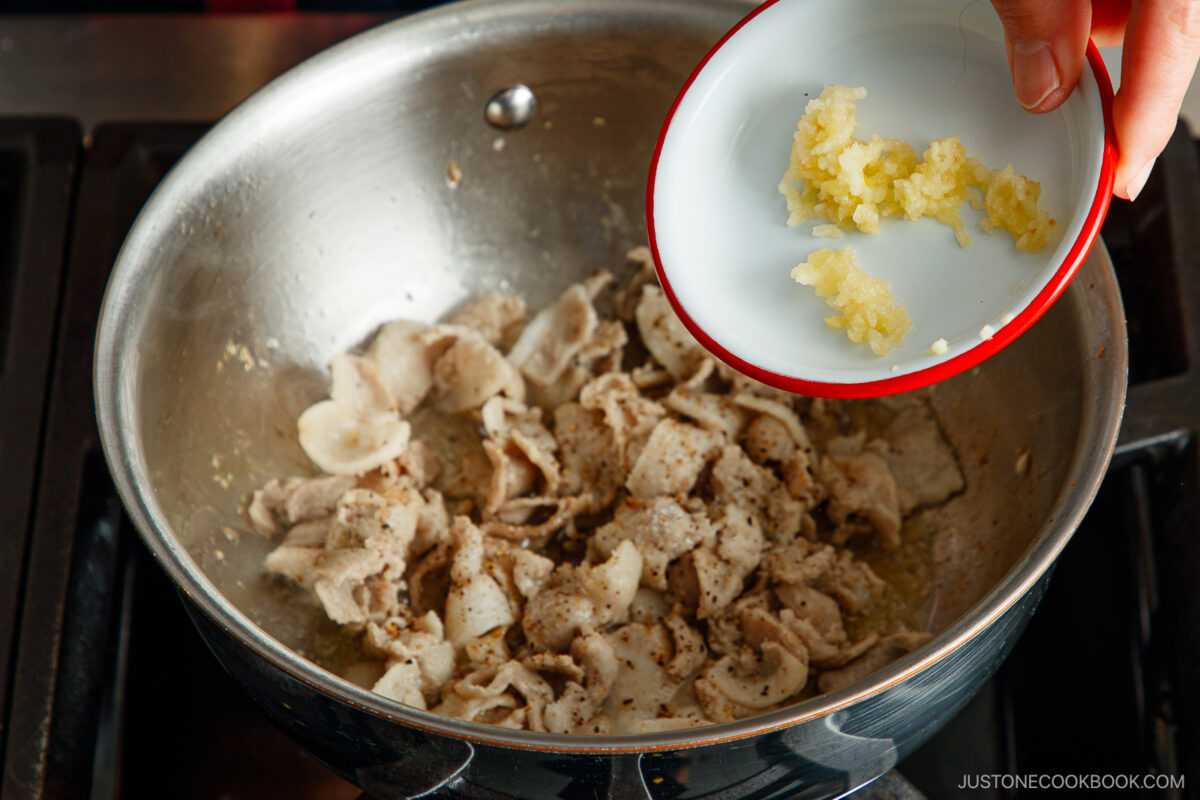
Step 3 – Stir in the vegetables and stock. Mix in the bean sprouts and chives. Add the chicken stock and water and bring it to a simmer.
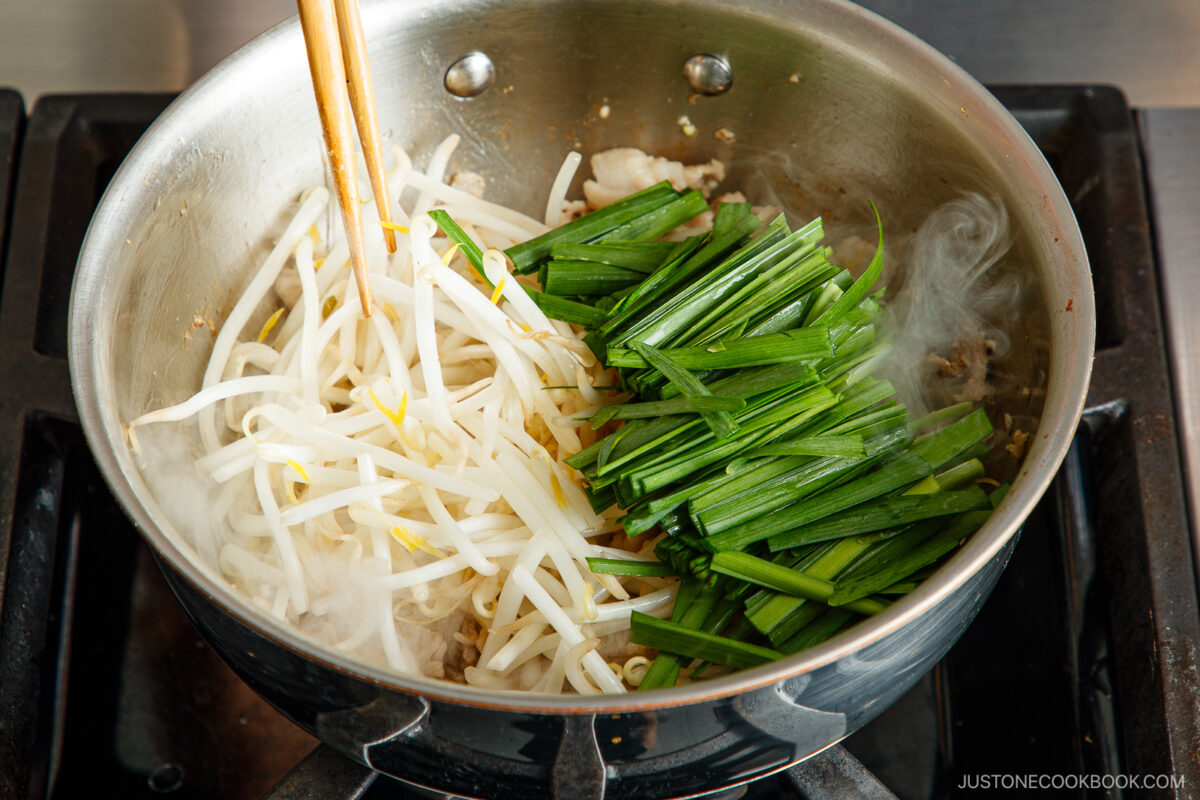
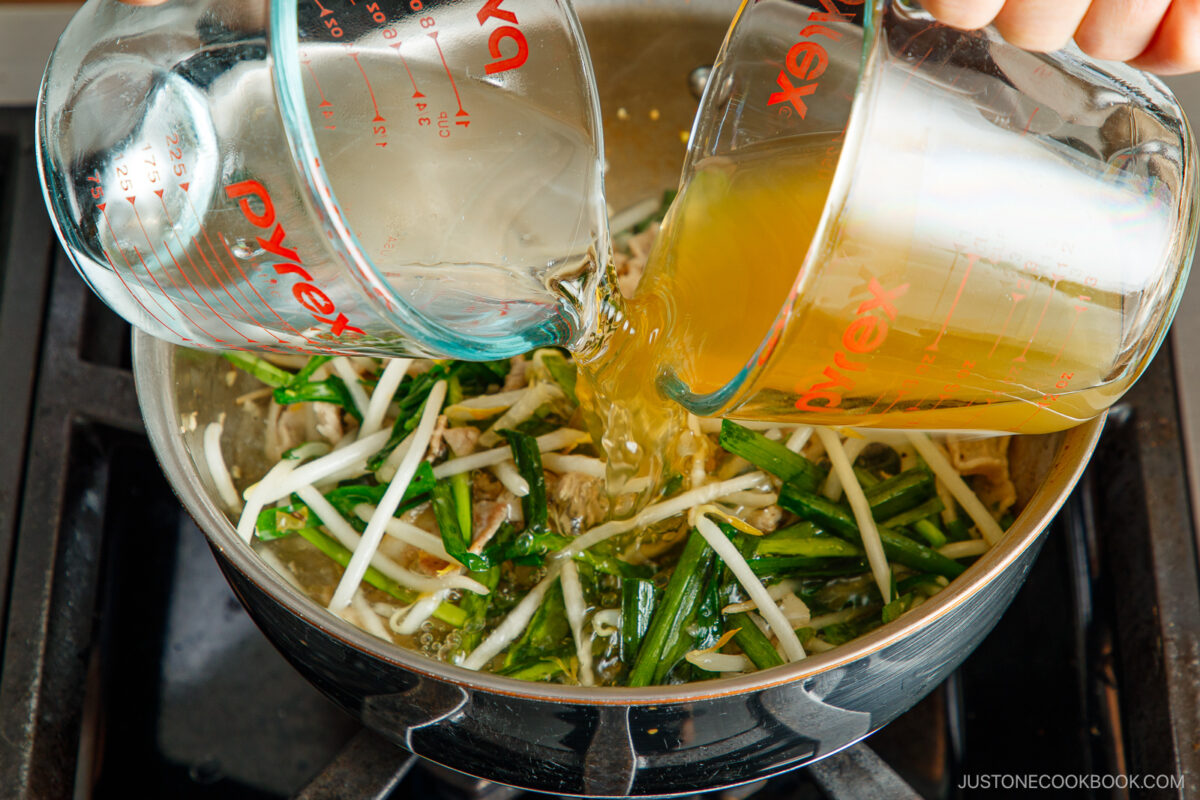
Step 4 – Add the miso and chili paste. Lower the heat, then dissolve the gochujang and miso into the broth. Bring it back to a bare simmer and turn off the heat.
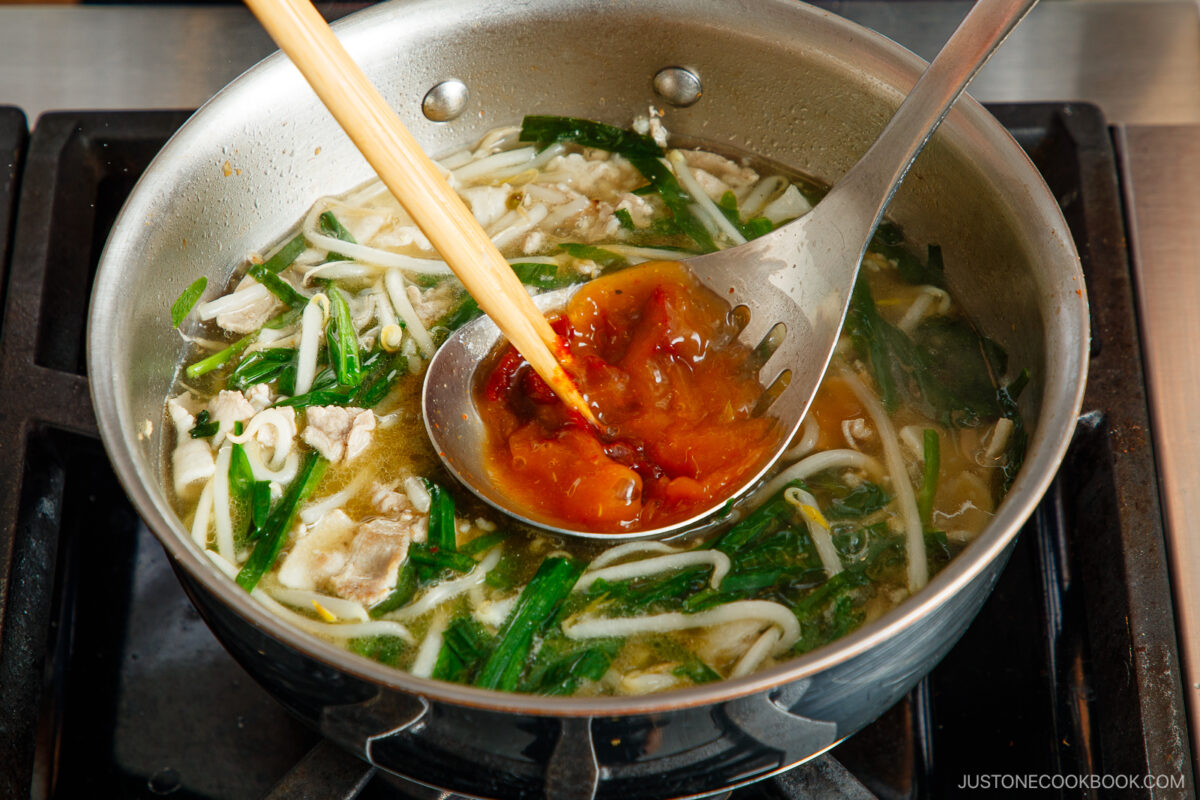

Step 5 – Serve. Portion into individual serving bowls and sprinkle with ground sesame seeds.

Nami’s Recipe Tips
- Dissolve the miso completely – To avoid clumps of paste in your soup, dissolve the miso and gochujang in a ladle with hot broth before releasing it to the soup. I often use a miso muddler and miso strainer to make this task even easier.
- Adjust the chili paste – Add more gochujang if you’d like it spicier. You can reduce or skip it for a milder soup. Be sure to taste the broth and adjust the salt level as gochujang contains salt.
- Don’t boil the miso – Miso loses flavor and aroma at high temperatures, so never let it boil. To warm up the soup to serve, I suggest bringing it to a bare simmer, then cutting the heat immediately.
- Toast the sesame seeds – To wake up the flavor, I highly recommend toasting your sesame seeds before grinding, even if you’re using the pre-toasted kind. Simply heat them in a dry frying pan, shaking constantly, until one or two seeds pop and they are lightly toasted.
Variations and Customizations
- Use another protein. Try thinly sliced beef, calamari, sliced chicken breast or thighs, shrimp, or regular to firm tofu. You could even try sliced bacon or minced pork.
- Try different chili sauces. Instead of gochujang, you can use different combinations of spicy chili condiments like doubanjiang or sriracha sauce.
- Add other seasonings. If you’d like, you can add a pat of butter or a teaspoon of soy sauce.
- Make it vegetarian. Use vegetable stock instead of chicken stock, and swap tofu or mushrooms for the meat.

What to Serve with This Soup
- A main course – A simple Miso Salmon or izakaya-style Yakitori goes well with this soup.
- A vegetable side – Simple and classic Green Bean Gomaae (Sesame Dressing) makes a refreshing contrast.
- Rice – Pair it with aromatic Ginger Rice.
- Noodles – Serve it with stir-fried Yaki Udon with cabbage, carrots, shiitake, and onions.
Storage and Reheating Tips
To store: It‘s best to consume all the soup right away because the miso will lose its aroma and taste as time passes. Completely cool any leftover soup and refrigerate for up to 3–4 days. You can freeze it for up to 2 weeks.
To reheat: Heat the miso soup in a pot over medium heat until it’s barely simmering. Do not boil it. Miso loses its nutrients, flavor, and aroma at high temperatures.
Frequently Asked Questions
Can I make this recipe ahead of time?
Yes. If you want to make a big batch for later, it‘s best to refrigerate the soup without adding the miso and gochujang. When ready to serve, bring the soup to a simmer, reduce the heat, and dissolve the miso and gochujang for the portion of soup you’re serving.


Prep Time: 3 minutes
Cook Time: 7 minutes
Total Time: 10 minutes
Japanese Ingredient Substitution: If you want substitutes for Japanese condiments and ingredients, click here.
Gather all the ingredients.
Please note: If you're using an electric pot like my son does in my Instagram reel, use Mode I (250W) on the electric pot the whole time.

To Prepare the Ingredients
Cut 1.5 oz garlic chives (Chinese chives or Nira) and 4 oz sliced pork belly into 2-inch pieces.

Mince 2 cloves garlic (I use a garlic press). Using a mortar and pestle, grind 1 Tbsp toasted white sesame seeds. I like to leave some seeds uncrushed for texture.
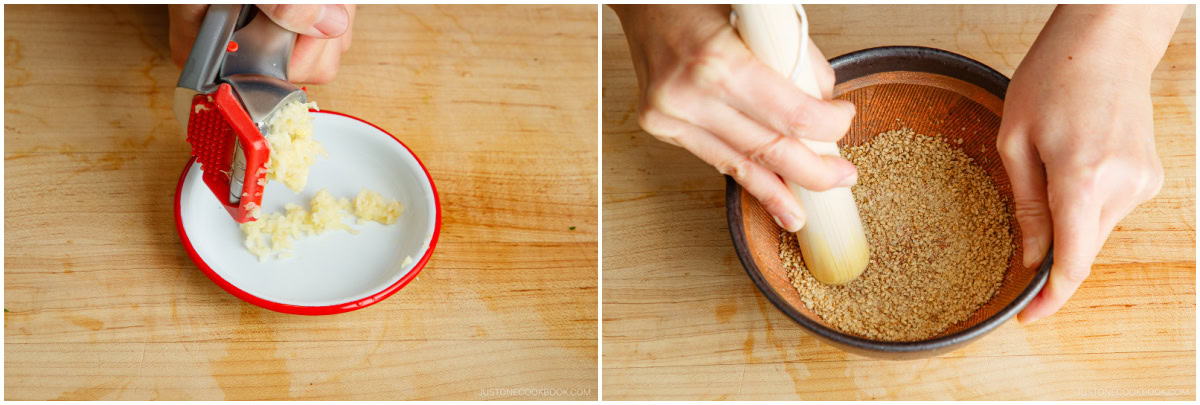
To Cook
Heat a saucepan on medium heat. When hot, add 1 Tbsp toasted sesame oil. Then, add the pork belly and stir-fry.

When the pork is no longer pink, season it with ⅛ tsp Diamond Crystal kosher salt and ⅛ tsp freshly ground black pepper. Add the minced garlic and stir.
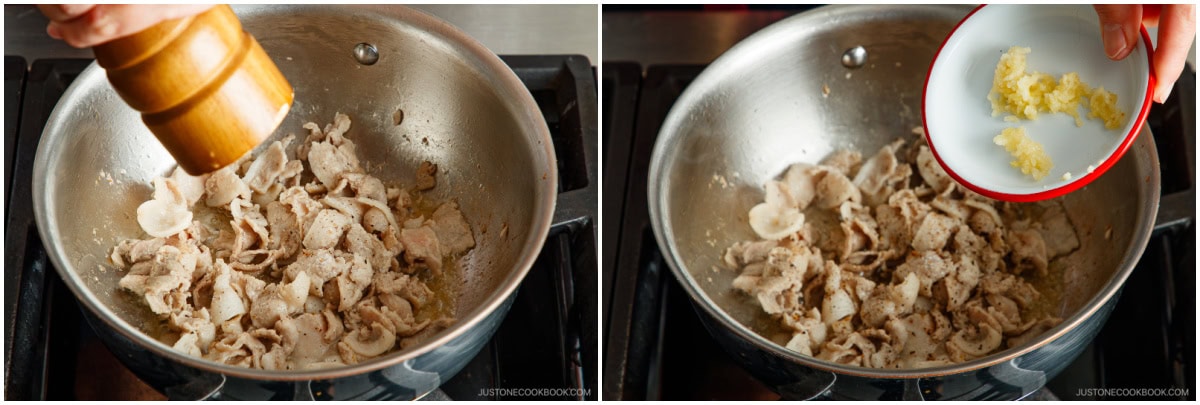
Add 4 oz bean sprouts and the garlic chives. Stir to combine.
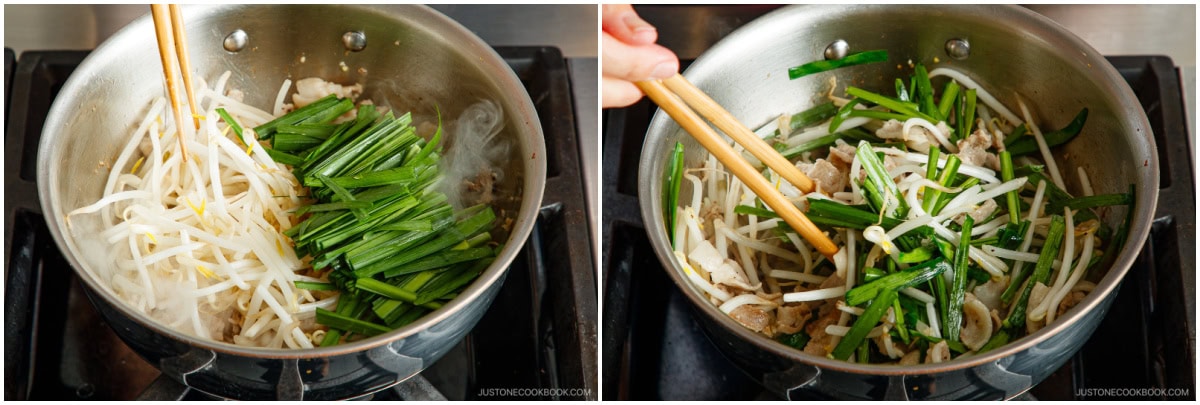
Add 1 cup chicken stock/broth and 1 cup water. Close the lid and bring it to a simmer.
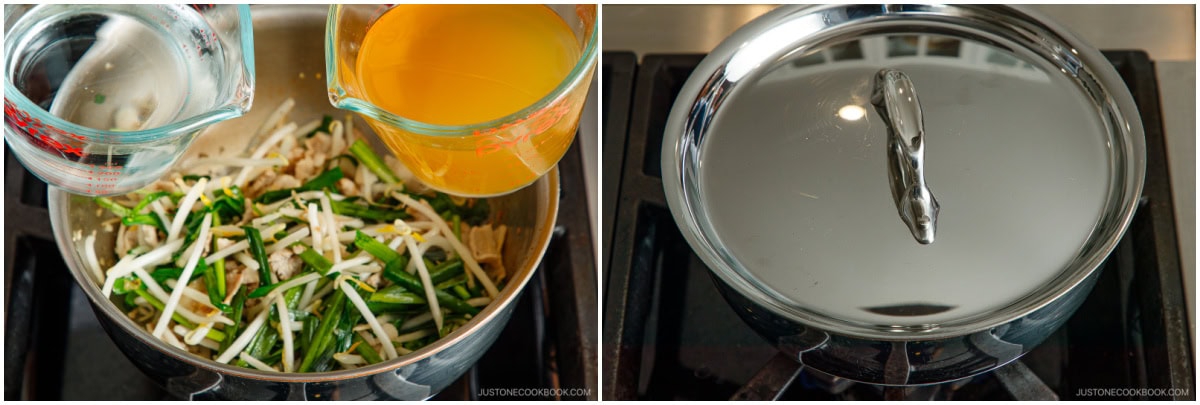
Once simmering, reduce the heat to the lowest setting. Dissolve 1 Tbsp gochujang (Korean chili paste) in a ladle with some hot broth, then release it to the soup. You could also use a miso muddler and miso strainer. Likewise, dissolve 1 Tbsp miso with hot broth, then stir it into the soup. Bring the soup back to a bare simmer. Don't let it boil as miso loses its flavor, aroma, and nutrients at high temperatures.
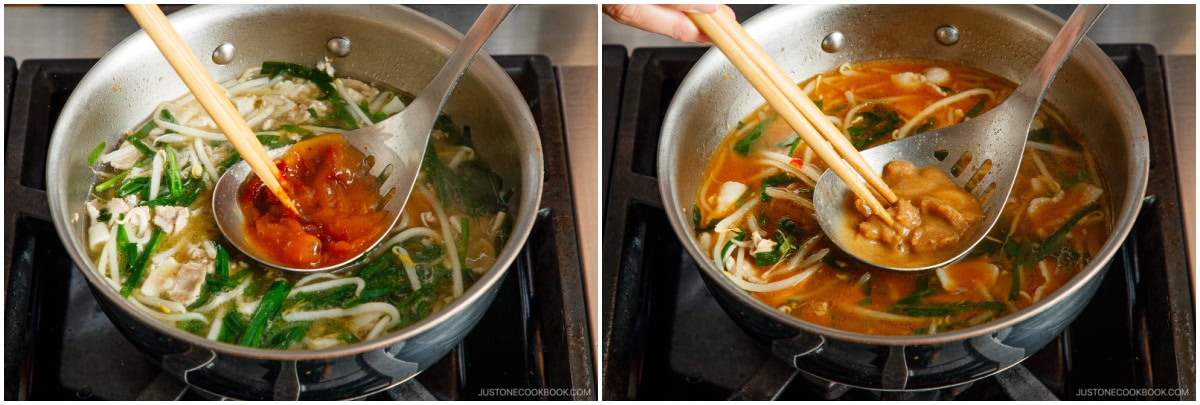
To Serve
Serve the soup in individual bowls. Sprinkle with ground sesame seeds and enjoy.
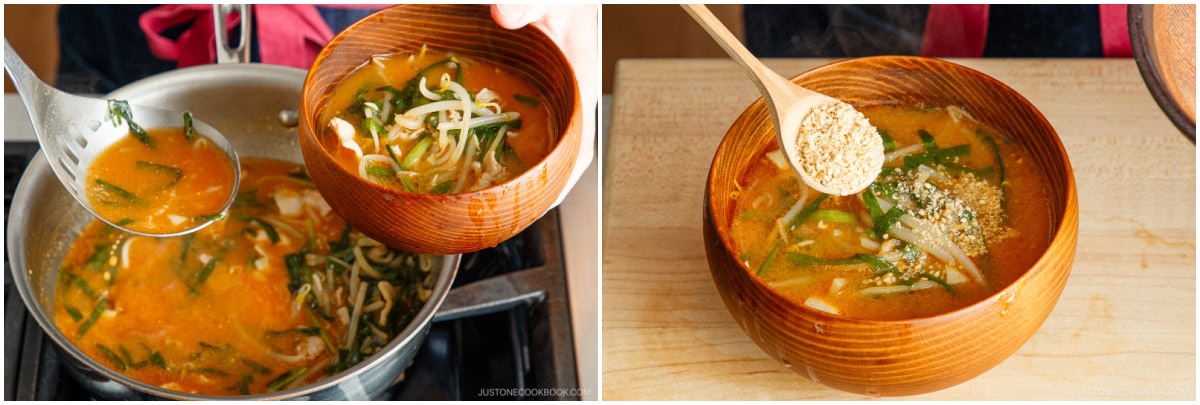
To Store
It‘s best to consume all the miso soup right away because it will lose its aroma and taste as time passes. Completely cool any leftover soup and refrigerate for up to 3–4 days. You also can freeze miso soup for up to 2 weeks. To reheat, bring it to a bare simmer in a pot over medium heat, but do not boil it. Miso loses its nutrients, flavor, and aroma at high temperatures.
Author: Namiko Hirasawa Chen
Course: Main Course, Soup
Cuisine: Japanese
Keyword: bean sprout, miso, pork belly
©JustOneCookbook.com Content and photographs are copyright protected. Sharing of this recipe is both encouraged and appreciated. Copying and/or pasting full recipes to any website or social media is strictly prohibited. Please view my photo use policy here.
If you made this recipe, snap a pic and hashtag it #justonecookbook! We love to see your creations on Instagram @justonecookbook!

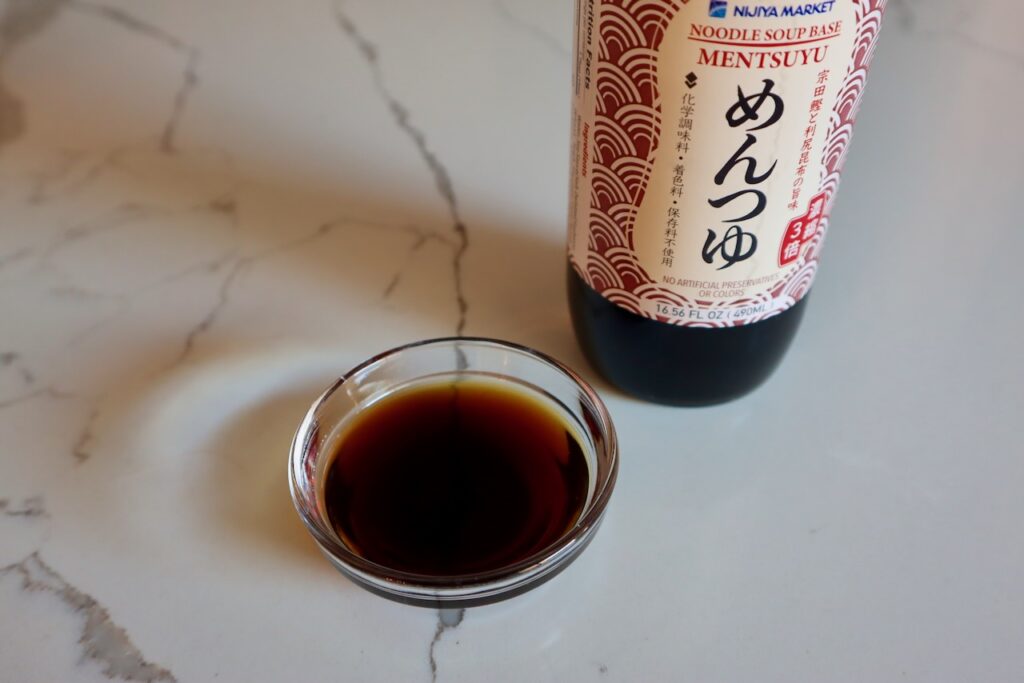

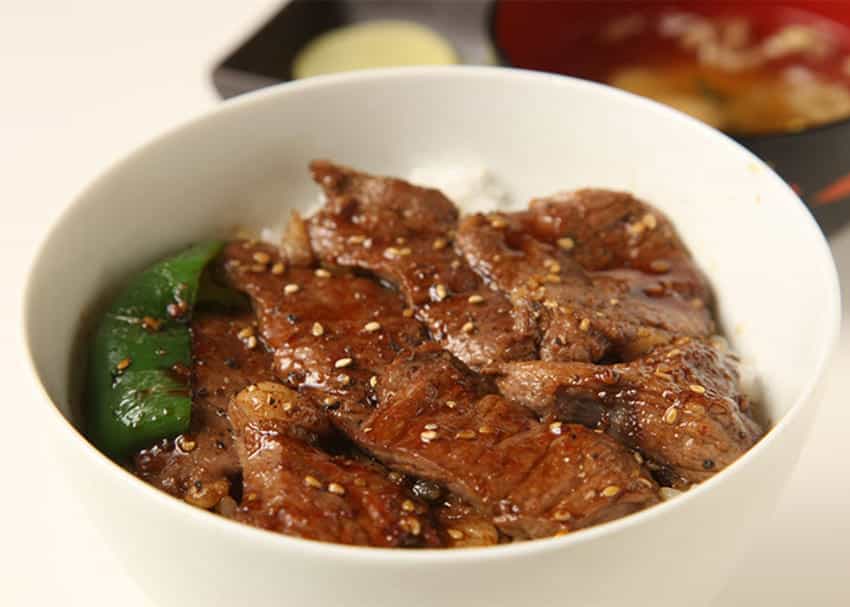
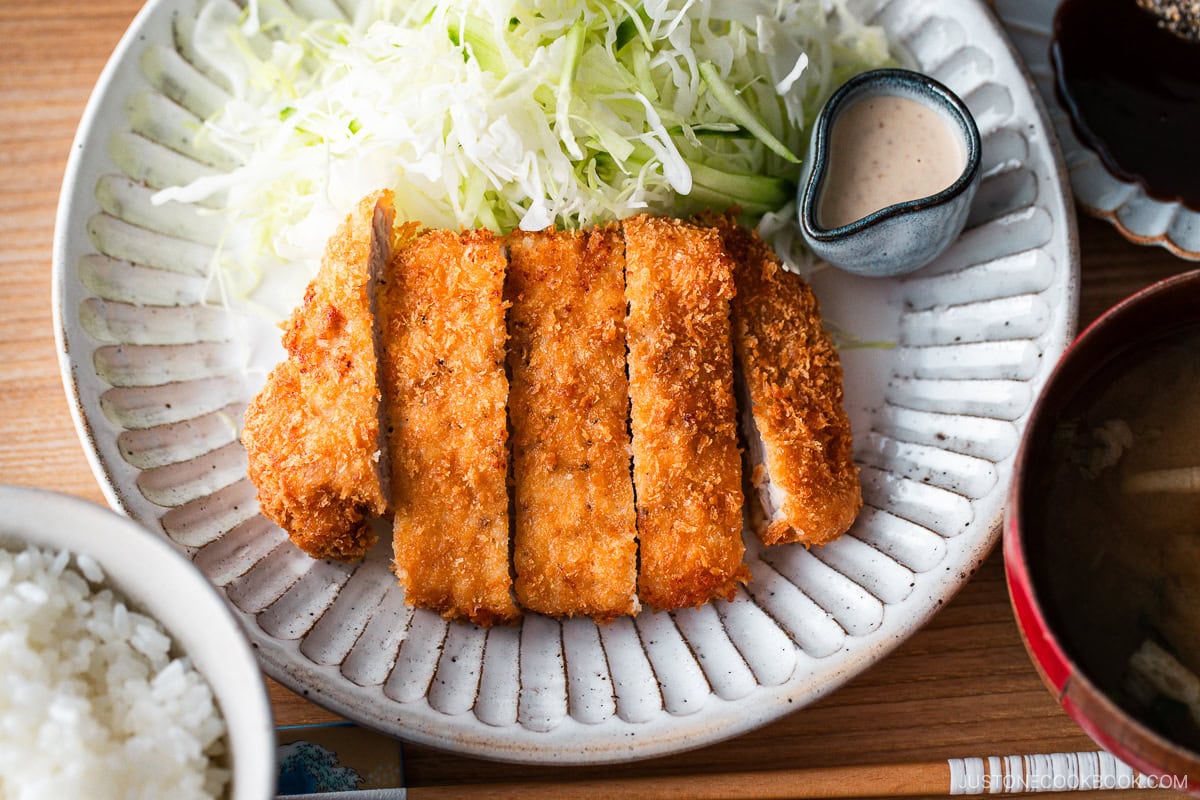






 English (US) ·
English (US) ·